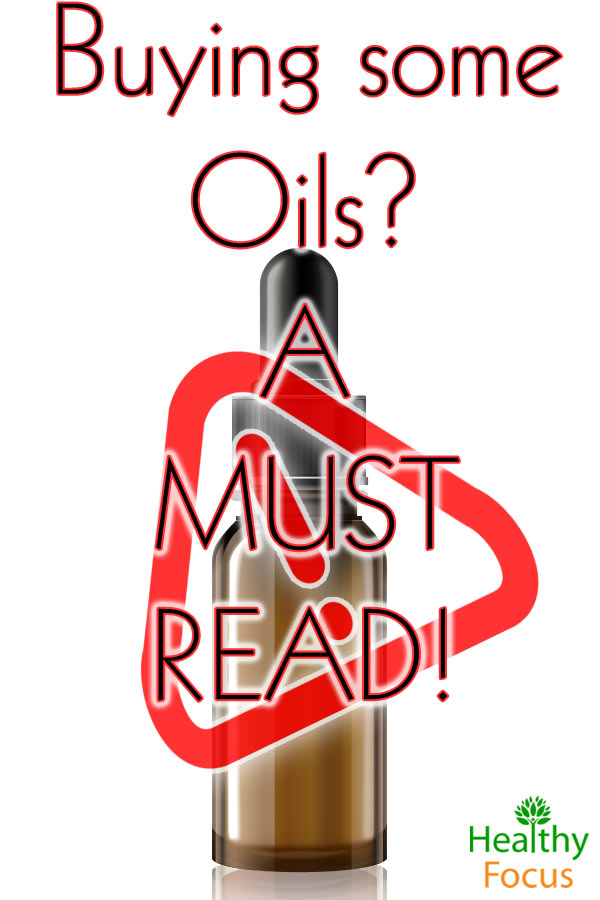Last Updated on February 4, 2019 by Marc Seward
How to Choose Essential Oils
Essential oils are quickly gaining popularity as home remedies for a variety of ailments. From ear infections to nail fungus to skin disorders, essential oils are proving to be effective remedies. You use these oils because they are safe and natural—so you want to make sure you are getting quality oils—but what does that mean?
I see many people recommending “quality oils”. All too often, that just means buy my brand. The brand may be good—but how can you tell? There are some real measures of quality. The purity and potency of the product and purity of plants used to make the oil are all important.
Essential Oil Labeling
You will often see people talk about “Therapeutic Grade”. It actually is not a real standard of any sort. However, unfortunately the term is so widespread that legit companies now use this largely nonsense term. ISO standards actually have more value and meaning but are rarely talked about because they are confusing to say the least (more about them later).
Purity of the plants means the plant is what it is. In the case of cinnamon essential oil, Cassia is often substituted. Both oils appear and smell similar but Cassia is about 10 times less expensive than Cinnamon bark oil. “Cinnamon” has few labeling requirements in the US—so in the grocery store Cassia and Cinnamon are mostly interchangeable.
Good companies will differentiate and use the Latin name and tell the plant origin where applicable. However, bad companies are also smart enough to put the Latin name in—so that in itself does not really tell you anything unless you trust the company to begin with.
Adulteration is another issue. Typically this is cutting an oil with a cheaper alternative or a synthetic scent. Rose otto, or Rose essential oil or Rose absolute is also often adulterated with Geranium oil. Geranium oil is a great oil but it costs much less than Rose absolute and has different properties.
Adulteration issues are a lower risk in cheaper oils such as lemon and orange. The costs to make the real oils is low so there is little to gain from adulteration. To be honest –with most reputable brands adulteration is not an issue.
Where fakes or adulterations are an issue is the myriad of “oils” or “scent oils” you often see for $10 for any oil possible on amazon.com. Sure lemon and some essential oils can probably be had for $10 or less. However, if you see Rose, Helichrysum, Jasmine Absolute, Neroli, Melissa, Violet or Sandalwood for cheap—I would be very skeptical of anything by that brand.
The prices I have seen are typically not even possible based on wholesale sources. If they lie about one they will lie about them all. These sellers are typically sourcing from Alibaba and searching for the lowest, rock-bottom price with no other concerns. They are looking to be #1 on the “Cheap essential oil” search on amazon.
Let them have their due but do not fall for it either. I honestly do not think readers on this blog fall into that category of bargain hunter. You may want a bargain—but it has to be real.
My advice for real bargain hunters is to stick to Mountain Rose Herbs or Plant Therapy. They are legit oils and value priced. If you find a vendor selling for lower than these two companies—then I would be suspicious of the quality. Now Labs is another value oil I trust. They have a limited selection and some oils are mixed with carrier—but they do tell you up front when that is the case. Their 20% frankincense and 2% rose absolute are two I know about for sure.
Essential Oil Potency
We are talking only about real oils here. We are assuming its 100% real essential oil—but even with that, there can be potency differences. Potency among real oils is based on how much of the active compound(s) are in the batch you got.
The potency is much harder to figure and it likely varies crop to crop—even within the same brand. The level of active compounds can vary based on what part of the plant is used for extraction (1) and even what season it is harvested in (2). Different varieties of plants used to make the oil will also produce a different chemical compound profile.
Essential Oil ISO standards and Composition
This is why there are ISO standards for oil compositions. There are also ISO standards for how they should be made, what part of the plant is used and even how it should be labeled and stored. Real essential oils are powerful plant cocktails composed of terpenes and other substances that give it drug like effects. Menthol, Camphor, Citronella, Eucalyptol are well known essential oil based compounds.
For example, Tea Tree Oil has over 98 chemical compounds but Terpinen-4-ol, γ-Terpinene, and α-Terpinene are the main components. Terpinen-4-ol is the “big daddy” responsible for most of the antiviral/antibacterial and antifungal benefits. Tea tree oil ISO composition standards are typically:
Terpinen-4-ol ≥30 %
γ-Terpinene 10-28 %
α-Terpinene 5-13 %
So even legitimate and ISO standard oils can have a wide range of composition. Good companies like Mountain Rose Herbs and Plant Therapy always stick to ISO standards and test against those standards—so you know you are getting a legitimate product.
In some oils, the ranges are even wider as there is more potential variation because of natural variability, season and plant cultivars. Other oils are simpler in composition. Eucalyptus oil must have 70% or more of 1,8-cineole (Eucalyptol).
The breakdown of citrus oils compounds is very interesting. D-Limonene is the major compound in many Citrus oils. Grapefruit and Orange essential oil are both 90% or more d-Limonene. Another Citrus oil, Bergamot is only around 60% d-limonene. However, Bergamot also contains Linalool (10%) and Linalyl acetate (17%)—which are typically found in Lavender Essential oil.
So you can start to see the “how and why” certain oils have a broad range of effects where others may have a more limited but potentially more powerful focus. Even though a simple classification might make you think, “All citrus oils are similar”.
The ISO standards will also contain information on what the Oils should not contain as well as differences in varieties. For example (Geranium Oil) straight from the standard:
“EXAMPLE:Guaia-6,9-diene is present in traces in the Africa geranium and present in higher concentrations in the Bourbon geranium. 10-Epi-gamma-eudesmol is absent in the Bourbon geranium and present in the Africa geranium.” (3)
I know exciting stuff, right? But this information is what drives the differences between the varieties and often these are why people say certain oil varieties are more powerful.
Essential oil Compounds in Medical Research
These compounds found in oils are typically what is used in medical research. If you find out about medical research or an oil having benefits—it is also good to know what compound provides the benefits. Beyond chemical composition, there are also purity concerns.
Purity in many cases also means organic—you are getting the essential oil and nothing else. Many companies will claim all their oils are organic or wild grown. Without certification, there is no way to know for sure if it truly is organic or non-GMO. The reason to get the label is to know a 3rd party tested it and says it is what they tell you it is.
The Importance of Organic Essential Oils
You want to know you are getting the great compounds that were actually responsible for the results of that latest medical experiment. In addition, you want to be make sure you are not getting pesticide or fungicide residue that could cause irritations or reactions.
For some oils, there may simply be no way you are going to get a certified-organic because of the country they are grown in. Other times organic is of limited value as the plant is truly wild grown or is one that does not require chemical pesticide or fungicide use. In those cases, the risks of pesticide contamination are minimal.
There are however, several essential oils where buying organic is clearly the best choice. In certain cases, there are crops where pesticides and or fungicides are regularly used.
Do I really need to worry about pesticides? Surely, they are extracted out during the processing right? Actually not necessarily. There is strong evidence to suggest that pesticides and fungicides not only survive the distillation process but also can become even more concentrated.
Certified organic oils for citrus (orange/lemon/mandarin/bergamot) and mint (peppermint and spearmint) oils specifically are highly recommended. There is a real risk of fungicide and biocide contamination that can survive steam distillation and solvent extraction.
Tetradifon and difocol are biocides used in citrus crops that can survive steam distillation. An Italian study in 2004 (4) showed trace amounts of these biocides in Bergamot essential oil.
The fungicides, Propiconazole and tebuconazole, are widely used to control mint rust fungus in spearmint and peppermint. Both of these fungicides survive the oil distillation process with Propiconazole showing up in higher amounts (5).
These studies show two key things:
- Pesticides and fungicides do in fact survive the steam distillation and solvent extraction process in measurable amounts.
- In the case of Propiconazole—it actually can co-distill with peppermint oil.
A recent French research in 2015 has found even scarier conclusions (6). The study found that as they concentrated the oil they also concentrated some of the pesticides. Going from the rose flower to rose absolute oil resulted in a 100-300 concentration factor. Meaning the essential oil had up to 300 times the amount of pesticide as the rose flower.
This risk seemingly would hold true on any situation where an oil is concentrated. Some pesticides not only survive but also actually co-distills with the active ingredients. So the pesticide concentrates along with the “essential” part of the oil.
While far from exhaustive, it does point to a strong need to buy certified organic for at least the oils in the studies. It is possible that the surviving pesticides and fungicides could cause skin irritation. The material safety data sheet for propiconazole (Dow brand Sanazole) specifically warns against inhalation and skin contact. (7)
In some cases, buying organic essential oils are even more important than buying organic food. You are getting a super concentrated oil and if you are not careful a super concentrated dose of pesticide. The rediscovery of essential oils is helping many people live better and healthier lives. Just make sure you know what you are getting before you buy.

What Brands do we recommend?
We believe in quality as well as value. If you can get a good pure oil at a good price—then we think that is the best value. Getting a potentially fake “scent oil” at a great price is of no value. Go buy a cheap air freshener if that is all you want.

The Brand we recommend the most is Mountain Rose Herbs. We are affiliates but for a good reason.
They have a wide variety of oils to choose from. Manuka, Benzoin and Tagetes Essential Oils are just a few of the useful oils that are hard to find legitimate oils on Amazon. In addition, you can read more about the benefits of Manuka here, Benzoin here, Tagetes and here.
They have the largest certified organic selection that I am aware of. They are actually certified organic –and often Free Trade.
You can request testing results to get the GC/MS (Gas Chromography/Mass Spectrometry) data on the oil.
They are value priced. Sure there are some oils cheaper but the combination of organic and standards is tough to beat.
In addition, I like the Hydrosols selection. Hydrosols are the leftover water after the essential oil extraction process. You can get Organic Rose and Helichrysum Hydrosols for well under $10. While not as powerful as the essential oil (nor nearly as expensive), they are nice to use for skin care. There is still “real stuff” in there—but not enough to get sensitized too. They also smell nice.
Plant Therapy is the other brand we recommend. They have a good variety and decent amount of organics. In addition, you can find them on Amazon as well.
Any of the MLM oils are also good quality. All of the GC/MS testing I have seen done by 3rd parties show that doTerra and Young Living do test within standards. My only issue with them would be from a value perspective. However, if you do not mind paying more and /or like the MLM structure–you are getting real oils.
No matter what brand you go with, I think Organics for the citrus and mint oils are always highly recommended.

I hope that this post answers more questions than it asks. If you have any questions please reply in the comments below!
(1) http://www.ncbi.nlm.nih.gov/pubmed/16756368
(2) http://www.ncbi.nlm.nih.gov/pubmed/14611181
(3) https://www.iso.org/obp/ui/#iso:std:iso:11024:-1:ed-1:v1:en
(4) http://www.sciencedirect.com/science/article/pii/S0045653504002929
(5) http://pubs.acs.org/doi/abs/10.1021/jf980120e
(6) http://pubs.acs.org/doi/abs/10.1021/acs.jafc.5b00985
(7) http://www.t3db.ca/system/msds/attachments/000/001/890/original/T3D3910.pdf?1413587764


Leave a Reply
You must be logged in to post a comment.